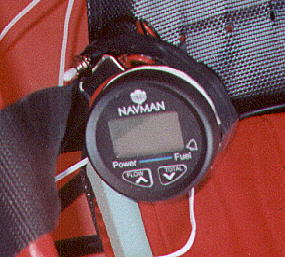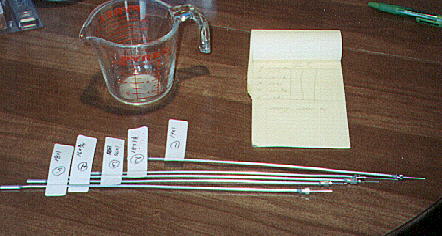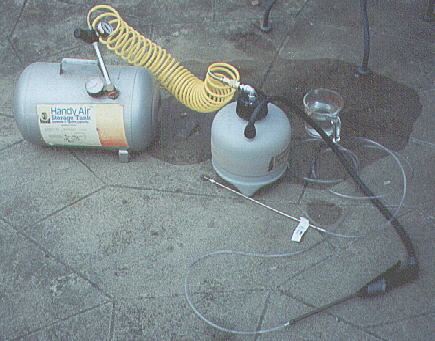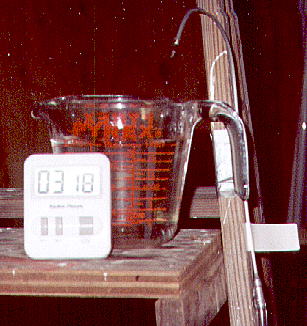|
|
|
|


|
|
I dug out my new fuel flow meter and temp installed it so I could get some good(?) data. To the left is the gas flow pickup spliced into the gas line and attached to an overhead brace with duct tape. The brain and display is on the right and it was powered by a nine volt battery. I tied the FireFly to the pickup, warmed up the engine and recorded the data. These data are shown on the red line in the following graph. I copied out and modified a graph from www.rotax-aircraft-engines.com so I could compare Rotax data. I had a tough time getting reliable data below 5000 rpm because the engine was unstable at these speeds. |
 The easiest thing to do would be to crank in more pitch on the prop to try and stabilize the engine at the lower speeds, but I wanted to try water injection in the exhaust to see if I could get the same effect and at the same time improve fuel economy. One of the ways that Skidoo two cycle engined racers improved low end and mid range torque was to inject water into the exhaust manifolds of the engines. They have a ready supply of water and they use complex to simple controls to inject the water in varying rates dependent upon engine rpm. Injecting water into the hot exhaust stream causes it to flash to steam and lower the density of the exhaust stream and decreased the speed of sound in the mixture. In doing so it makes an exhaust system tuned for 6000 rpm act like a system tuned for a lower rpm. |
 I assumed five gallons would be a reasonable limit and so I had to come up with a source for testing. I selected a group of hypodermic needles from a farm store and joined them to small aluminum tubes so that I could test them for flow rates.
I assumed five gallons would be a reasonable limit and so I had to come up with a source for testing. I selected a group of hypodermic needles from a farm store and joined them to small aluminum tubes so that I could test them for flow rates.
|
 The test setup consists of an air bottle fitted with a pressure regulator feeding a hose that connects to an old hand pump sprayer bottle with the pump removed. Water was placed in the sprayer bottle and forced out through the valve wand, Tygon tubing, and the needle. Flow rates were determined by timing the period to fill a measuring cup to two cups of water. Only the smallest needle gave reasonable flow rates.
The test setup consists of an air bottle fitted with a pressure regulator feeding a hose that connects to an old hand pump sprayer bottle with the pump removed. Water was placed in the sprayer bottle and forced out through the valve wand, Tygon tubing, and the needle. Flow rates were determined by timing the period to fill a measuring cup to two cups of water. Only the smallest needle gave reasonable flow rates.
|
 Flow through this needle was calibrated at the head height of the exhaust elbow on the 447. At 10 psig, the flow was 0.96 gph and at 20 psig it was 2.27 gph.
Flow through this needle was calibrated at the head height of the exhaust elbow on the 447. At 10 psig, the flow was 0.96 gph and at 20 psig it was 2.27 gph.
|
 A small hole was drilled into the exhaust elbow so that the needle could be inserted so it would spray the water toward the muffler. Safety wire held the needle in place. The aluminum tube was fed forward toward the cockpit. The Tygon tubing was run down and secured to the left vertical member just behind the seat so that it could not get into the prop.
A small hole was drilled into the exhaust elbow so that the needle could be inserted so it would spray the water toward the muffler. Safety wire held the needle in place. The aluminum tube was fed forward toward the cockpit. The Tygon tubing was run down and secured to the left vertical member just behind the seat so that it could not get into the prop.
|
 The valve in the wand could be locked in the on position. With the air bottle on the left side I was able to adjust air pressure over the water from the cockpit. With the plane secured to the pickup, the engine was started and warmed up. Then the first series of data were taken with no water flowing, then the pressure was set for 10 psig and the valve was locked on, and the second series of data were taken. The pressure was raised to 20 psig and the process repeated followed by another no water run to be sure nothing had changed.
The valve in the wand could be locked in the on position. With the air bottle on the left side I was able to adjust air pressure over the water from the cockpit. With the plane secured to the pickup, the engine was started and warmed up. Then the first series of data were taken with no water flowing, then the pressure was set for 10 psig and the valve was locked on, and the second series of data were taken. The pressure was raised to 20 psig and the process repeated followed by another no water run to be sure nothing had changed.
 The plots from 6000 to 4400 rpm are the data that were recorded. The black line is no water, the blue line is 10 psig water, and the green line is 20 psig water. There was a marked lowering of fuel flow due to the water injection. The best being 15.2% decrease at 5200 rpm. But the stabilizing effect I had hoped for in the 4000 to 5000 region was not realized. This was interesting and may be much more effective on a smaller displacement engine. The reason that the no water curve does not fall on the red line is because I had to change needle positions before taking the water injection data. I have increased the pitch of the prop to increase engine load. Max engine rpm is currently 5600 rpm. The FireFly will climb at 500 fpm at this rpm. Slowest cruise is 18 mphi at 4000 rpm. EGT's were a little low, but the engine rpm is very stable through the 4000 to 5000 region. I will tie it to the pickup and make another fuel flow run and put the data on the plot. |